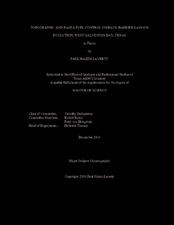| dc.description.abstract | Estuaries are economically and ecologically significant regions that are highly sensitive to external forcing from sea-level rise, storm events, and anthropogenic change. West Galveston Bay (West Bay) is a back-barrier lagoon system located immediately landward of Galveston Island, Texas, and it represents a sub-system of the larger Galveston estuary complex in the Northern Gulf of Mexico (NGOM). Previous studies have documented the evolution of many large estuaries along the NGOM in response to Holocene sea-level rise. However, the prehistory of smaller estuaries like West Bay remain largely overlooked and poorly understood. The primary purpose of this study is to complete a paleoenvironmental reconstruction of West Bay in Texas using geophysical and sedimentological approaches. A total of 30 core samples and more than 160 km of CHIRP seismic data were collected from West Bay and neighboring Chocolate Bay, within which several unique lithofacies and seismic facies were identified. As with other regional studies, the Pleistocene unconformity presents as an impedance change in the seismic profiles, and is most likely the Beaumont Formation. Multiple incised channels were observed on the Pleistocene Unconformity that are most likely seaward extensions of the tributaries that flow into Chocolate Bay, and formed the basal surface of the accommodation available for Holocene infill.
Radiocarbon dating of salient lithologic and seismic transitions in a few key cores revealed that several flooding events related to Holocene sea-level rise caused the landward back-stepping and geographic reorganization of depositional environments within West Bay. The first flooding event occurred at ~7,600 Cal. yr. BP caused both fluvial-dominated sedimentation to cease and initiation of estuarine conditions. The next flooding event occurred at ~6,800 Cal. yr. BP tripled the spatially inundated area and created ideal brackish conditions for oyster reef proliferation. This was short lived, however, as reduced salinity and increased turbidity from the paleo-Brazos River that was flowing into the area between ~6,100 and ~4,400 Cal. yr. BP ceased oyster reef production. The final flooding event occurred at ~4,400 Cal. yr. BP, which possibly established the connection between Galveston Bay and West Bay. At this time, an ephemeral tidal inlet formed within the incised channels, and then migrated west until stabilizing in the paleo-Brazos River incised valley as the modern day San Luis Pass.
This study reveals how the antecedent topography and sea-level rise controlled the environmental changes within West Bay throughout the Holocene. It also provides insight into how a small coastal system responds to varying rates of sea-level rise. Additionally, it may be useful as a baseline for West Bay for predicting future flooding associated with accelerating rates of sea-level rise. | en |


